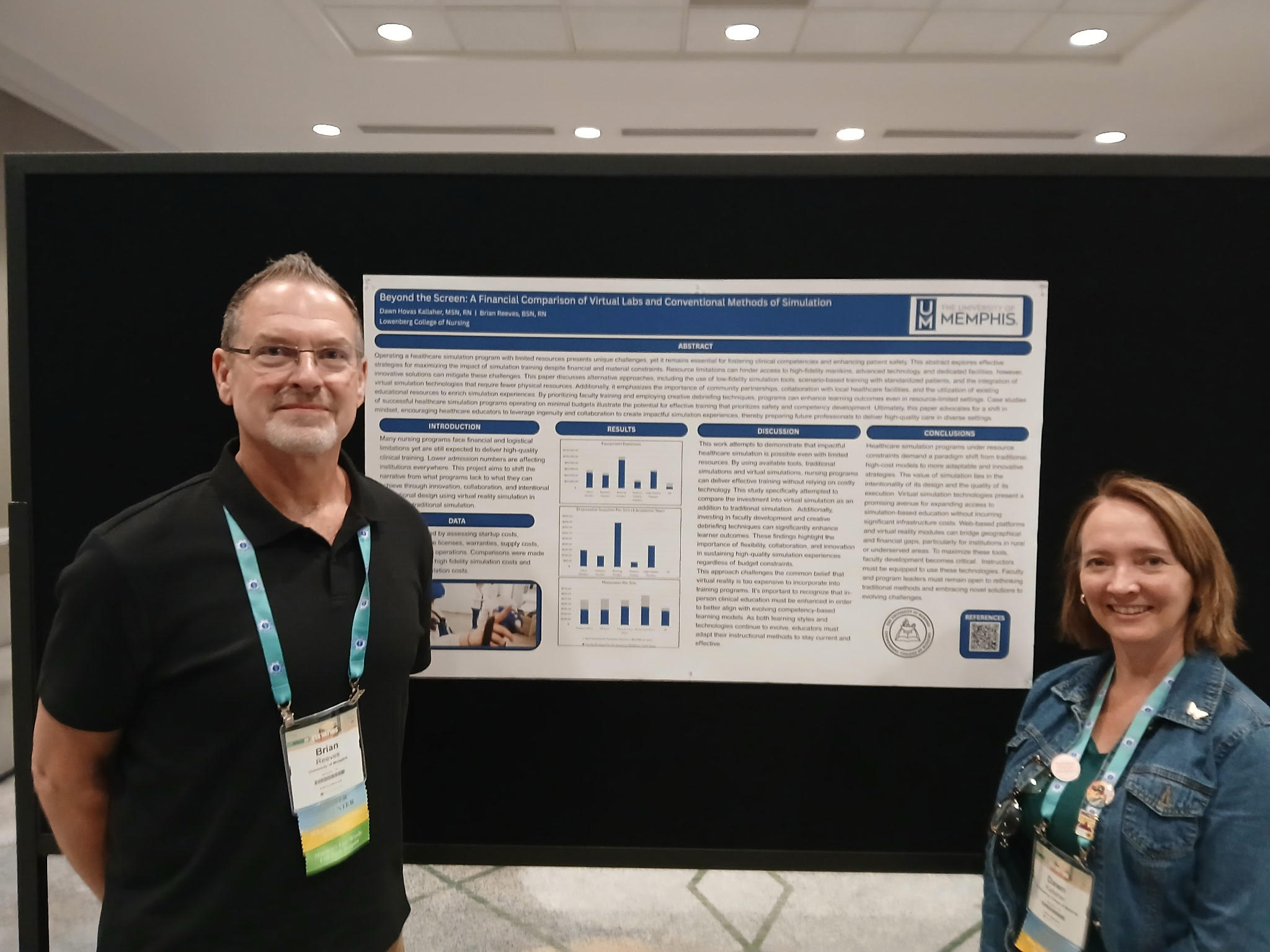Simulation on a Budget: Comparing Manikins and VR Costs Under RCM

Table of Contents
Name of the heading
1- Start your table with the syntax {start-table}
2 - Add an H3 Heading to create a new column (this will be the column title)
3 - List cells as bullet points in a List element
4 - End your table with the syntax {end-table}
By Brian Reeves, BSN, RN, Nursing Laboratory Manager, Loewenberg College of Nursing, Lambuth Campus & Dawn Hovas Kallaher, MSN, RN Director of Simulation & Clinical Assistant Professor, Loewenberg College of Nursing, Memphis Campus
As the Director of Simulation and Nursing Lab Manager at the Loewenberg College of Nursing, we’re living through a transition many of you may recognize. Our university recently adopted a Responsibility Center Management (RCM) budget model.
If you’ve experienced this shift, you know the impact it has on day-to-day operations. Instead of depending on broader university funds to help cover costs, each college is now responsible for generating its own revenue and managing its own expenses. That means every choice we make in the simulation lab, whether it’s investing in equipment, replacing consumables, or expanding access, has to fit the budget.
In the past, our simulation department enjoyed a degree of financial flexibility, with university-level funds often covering additional costs. This support gave us the freedom to grow, experiment, and innovate without watching every penny. Today, under the RCM model, every expense must now be carefully planned, justified, and aligned. The margin for error is much narrower than before.
This new environment has pushed us to think differently about how we allocate resources, especially when it comes to balancing traditional manikin-based simulation with newer virtual reality (VR) tools.
The Budget Pressures We Face
This new budgeting model arrived at a time when several external challenges were also taking shape affecting student enrollment which in turn directly affected our budget:
- Admissions standards are rising, narrowing our applicant pool.
- The national “demographic cliff” is beginning to show its effects, with declining enrollment forecasts.
- As enrollment drops, tuition-driven revenue declines too, shrinking what’s available for simulation growth.
Strategic planning is no longer optional; it’s essential.
Why We Ran the Numbers
When I (Brian) was hired as the Lab Manager at the Lambuth campus, I had no idea one of my first assignments would be building a virtual reality nursing lab—one of the first in our area. We had just received a grant for this purpose, and because the Lambuth campus was awarded those funds, I was tasked with launching it.
After getting the VR lab up and running successfully for a couple of years, we began asking the natural next question: how could we extend VR access to our main campus? And more importantly, could we actually afford the expansion under RCM?
That’s what prompted us to compare the real costs of traditional manikin-based scenarios with those of VR. We already had detailed records of the expenses tied to traditional simulation—equipment, maintenance, consumables, space usage, faculty time. With a fully operational VR lab at Lambuth, we were able to collect similar data for VR.
Some clear differences quickly emerged.
In-House Cost Analysis: Manikins vs. VR
1. Upfront Costs
If you’ve ever priced manikins, you know the sticker shock. They can cost up to $100,000 for a single manikin. Beyond the manikin itself, you need beds, monitors, and supporting equipment. VR requires less upfront investment: headsets and software. And unlike physical equipment, VR offers multiple types of clinical scenarios in one platform without additional purchases.
2. Ongoing Maintenance
This is where traditional simulation adds up quickly. Manikins break down. They require constant upkeep. Some of ours need $8,000–$10,000 per year in warranties alone. In contrast, VR maintenance is much lighter—software updates and the occasional hardware refresh. That frees resources for other priorities.
3. Staffing Demands
Running back-to-back manikin simulations is a heavy lift. You set up the space, run the session, debrief, reset—and do it all over again. VR lightens that load with minimal setup, allowing our staff to focus less on logistics and more on supporting learners.
4. Scalability
Physical space limits how many learners we can serve at once. VR removes many of those barriers. Multiple students can train simultaneously—even remotely—which opens new doors for access across campuses.
5. Flexibility & Customization
Traditional simulations are tied to specific rooms and setups. VR is portable, adaptable, and customizable to different learners and objectives. That flexibility has been hard to ignore in our planning.
Why It Matters
We are hopeful the results of this cost analysis will help drive our budgeting decisions, justify funding requests, and potentially open the door to more scalable and sustainable simulation solutions. In an RCM-driven environment, data-driven decisions are essential. Having clear, detailed cost comparisons strengthens our case when advocating for investments that truly align with both educational goals and financial realities. One of our current projects is to develop virtual scenarios that would help to train preceptors working with our students. This would not only be beneficial to us but would also benefit our clinical partners by strengthening their workforce.
What We’d Tell Our Peers
We’re not suggesting VR should replace traditional simulation altogether. Both have unique strengths. But if your college is under financial pressure (and whose isn’t right now?), our biggest takeaway is this: don’t wait to run the numbers. Compare the full costs—equipment, maintenance, staffing, scalability—side by side.
That analysis will give you the clarity you need to advocate for resources and make informed choices about where to invest next. For us, it’s not about choosing one tool over the other. It’s about using both wisely, in ways that strengthen learning and keep simulation sustainable.
FAQs
Heading 1
Heading 2
Heading 3
Heading 4
Heading 5
Heading 6
Lorem ipsum dolor sit amet, consectetur adipiscing elit, sed do eiusmod tempor incididunt ut labore et dolore magna aliqua. Ut enim ad minim veniam, quis nostrud exercitation ullamco laboris nisi ut aliquip ex ea commodo consequat. Duis aute irure dolor in reprehenderit in voluptate velit esse cillum dolore eu fugiat nulla pariatur.
Block quote
Ordered list
- Item 1
- Item 2
- Item 3
Unordered list
- Item A
- Item B
- Item C
Bold text
Emphasis
Superscript
Subscript
Explore more

From 30 Minutes to 3: How AI Enhanced Analytics Transforms Debriefing Preparation
AI Enhanced Analytics: Scenario Performance Data now available in UbiSim's Version 1.19
.jpg)
Behind the Scenes: How We Brought Incisions & Dressings to Life in VR
How the UbiSim team built a VR system displaying 300+ distinct incision states—balancing clinical accuracy, technical constraints, and nursing education needs.
.jpg)
Step Inside the Room of Errors: Playful Exploration, Serious Skills
Learn how UbiSim's Room of Errors transforms nurse training through investigative play. Students spot hidden safety risks and build situational awareness.





